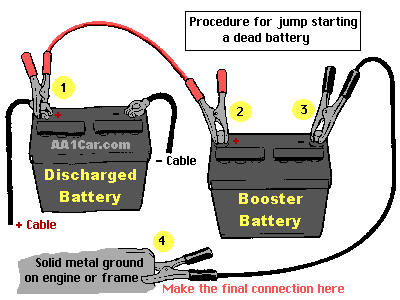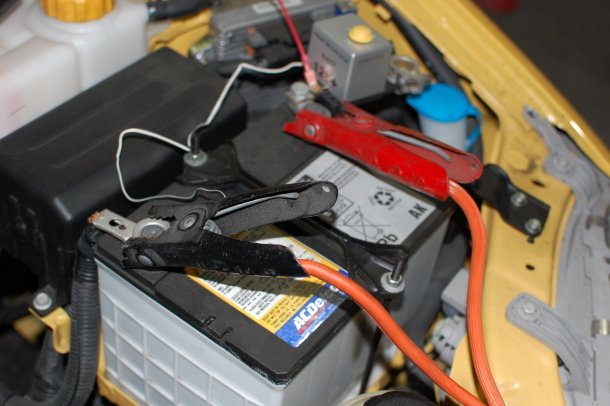
Safe Battery Jump Start Procedure
If a battery is dead or too low to crank the engine, you can jump start it using a pair of jumper cables to connect the low/dead battery to a good battery in another vehicle.
Pull the other vehicle as close as possible to the one with the dead/low battery, but DO NOT allow the vehicles to touch. Open the hood on both vehicles, and shut OFF the engine in the other vehicle.
Jumper cables are color coded, RED for POSITIVE (+) and BLACK for NEGATIVE (-). DO NOT mix up the cables or allow the metal ends to touch together because this may damage the battery, charging system and/or electronics on a vehicle.
To jump start the battery, proceed as follows:
1. Connect one end of the RED jumper cable to the POSITIVE (+)post on the dead battery. The POSITIVE battery post will be slightly larger than the NEGATIVE post, and will be marked with a PLUS (+) sign. There may also be a RED plastic protective cover over the positive bttery post.
2. Connect the other end of the RED jumper cable to the POSITIVE (+) post on the good battery.
3. Connect one end of the BLACK jumper cable to the NEGATIVE (-) post on the good battery.
4. Connect the other end of the BLACK jumper cable to a heavy metal ground on the engine or frame of the vehicle with the dead battery. DO NOT make the final jumper connection to the NEGATIVE (-) post on the battery itself because it usually sparks and may ignite hydrogen fumes in the dead battery causing it to explode.
NOTE: On some vehicles the battery is not easily accessible (because it is located inside a fender panel, trunk, etc.), so there may be special jumper connections in the engine compartment for jump starting the vehicle.
CAUTION: DO NOT lean directly over the battery while making jumper connections (in case of explosion).
5. Start the vehicle with the good battery, and run the engine at a fast idle (1200 to 1500 rpm)for a couple of minutes. This will help charge up the low battery and make starting easier.
6. Now you can start the vehicle with the dead battery. If it does not crank or cranks very slowly, wiggle the jumper connections to make sure they are making good contact. Then try again. The engine should start if there are no other problems (such as a bad starter or ignition circuit problem).
7. As soon as the engine starts, disconnect both jumper cables. Do not allow the metal ends of the jumper cables to touch each other or the RED cables to touch anything metal on either car.
8. Keep the engine running 20 to 30 minutes, or drive the car to recharge the battery. During this time, leave the lights, heater, A/C and other electrical accessories off so all of the charging system's output can go into the battery.
NOTE: If the engine dies shortly after it has been jump started, or as soon as the jumper cables are disconnected, it probably means the charging system is not working (bad alternator, voltage regulator, wiring problem or loose/dirty battery cables).
If the vehicle runs okay and the battery charges up, you should clean and tighten both battery cables after shutting the engine off. The battery and charging system should also be tested to make sure both are working properly
Sunday, July 5th, 2009 AT 10:55 PM




